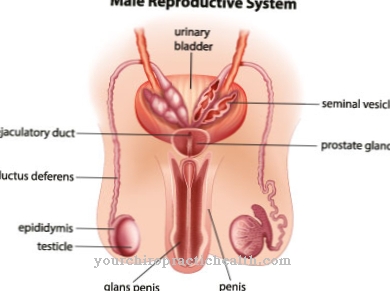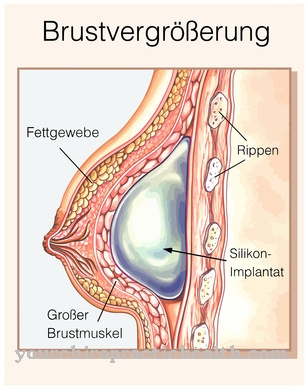Abrasions and small cuts on the hand can easily occur when using tools or when doing gardening or housework and are often ignored. If the symptoms persist, however, you must also Hand infections be thought.
What are hand infections?
.jpg)
© piXuLariUm - stock.adobe.com
Hand infections often occur after an injury caused by germs, which can more easily penetrate the skin via the wound. On the inside of the hand, they can penetrate deep into the tissue because the skin there is particularly tightly connected to the tissue layers below.
The same applies to the tissue on the flexor side of the fingers. In the case of hand infections, depending on the type of infection, the forms Panaritium, paronychia and phlegmon distinguished. Panaritium is a general description for an infection on the fingers, which can occur both in the joint, under a nail and under the skin.
Paronychia, on the other hand, is an infection in the lower part of the nail bed, the so-called nail wall. Phlegmon is a hand infection of the cupped hand or the tendon sheaths. The fingers are not affected here.
causes
The causes of hand infections of all three forms are often staphylococci or fungi, which can invade the skin after a self-inflicted injury. The use of tools, nail care or animal bite injuries can also lead to hand infections.
Once the germs have penetrated the wound, inflammation occurs. Hand infections can occur more easily with certain pre-existing conditions. These include patients with an immune deficiency, but also cancer patients and diabetics. Circulatory disorders also favor the development of hand infections.
Symptoms, ailments & signs
Hand infections such as paronychia or phlegmon initially manifest themselves as inflammation in the affected area of the hand or finger. Sometimes pus vesicles or swellings form that are painful when you apply pressure. As the disease progresses, pain from movement may also occur, which can spread to the entire hand.
Depending on the type and severity of the infection, the nerves of the hand can also be affected. Then symptoms of paralysis or sensory disorders can occur. In addition, there are typical symptoms such as fever and malaise. The hand feels hot and is very sensitive to pressure. Those affected usually feel a throbbing pain.
Externally, a hand infection can primarily be recognized by its visible reddening. This usually occurs shortly after the infection with the pathogen and increases in size in the first few days. Eventually a blister or swelling will form. The hand infection usually goes away by itself, provided that the person concerned observes strict personal hygiene and otherwise takes care of himself. In severe cases, the infection can progress and spread to other areas of the body. This can be recognized by an increasing feeling of illness and severe pain in the hand.
Diagnosis & course
The doctor can easily identify hand infections based on the symptoms described, such as pain, swelling and the existing restricted mobility. The hand is also very sensitive to pressure and is warmer than a healthy hand. All of these symptoms already indicate an inflammatory reaction.
If the hand infection progresses, the patient may experience a general feeling of illness with fever and chills. The lymph nodes in the armpits are also swollen and give the doctor another indication of inflammation. This can be proven with a blood test. To find out what kind of germ it is, a smear is taken from the wound.
If deep-lying soft tissues or bones and joints are already affected by hand infections, an X-ray, an MRI (magnetic resonance tomography) or a CT (computer tomography) must also determine how far the infection has progressed.
Complications
In most cases, hand infections do not lead to particular complications and do not need to be treated by a doctor. They often heal on their own if the hands are cared for and there is a high standard of hygiene. Without treatment, hand infections primarily result in severe pain. This pain can occur under stress or in the form of resting pain and lead to sleep problems at night.
The hands are also reddened and possibly covered with spots and swollen. The movement of fingers and hands is severely restricted by the hand infections and the pain, which can lead to limitations and complications in everyday life. Under certain circumstances, the affected person can no longer carry out his professional activity due to the hand infections. Due to the infection itself, patients often suffer from fever and pain in the extremities.
Headaches and chills also occur. The hand infections are treated with the help of antibiotics and pain relievers. There are no further complications if the person concerned takes care of their hands and rests. If the person concerned does not pay attention to adequate hygiene, blood poisoning can also occur. In many cases this leads to death.
When should you go to the doctor?
Since hand infections can spread to other areas and regions of the body and lead to symptoms and complications there, hand infections should always be treated by a doctor. The doctor should be consulted if the typical symptoms of hand infections arise after a cut or other injury to the hand. This includes burning and stabbing pain, which is accompanied by redness. Swelling can also occur in the hand and lead to a restriction in movement.
As a rule, severe hand pain also indicates a hand infection. An infection can also lead to fever or paralysis of the hand. If these symptoms occur, immediate treatment by a doctor is necessary.
The hand infections can be treated by a general practitioner. A visit to a hospital is only necessary in serious cases. Normally, the disease progresses quickly.
Doctors & therapists in your area
Treatment & Therapy
The earliest possible therapy prevents the infection from spreading. An abrasion should be treated with disinfectant at home, if possible, and then protected with a plaster.
If such a wound does not improve within a few days, a doctor must be consulted. Therapy then requires treating the wound and taking an antibiotic. Painkillers can also be taken if the pain is severe. It is also very important to check the current vaccination status against tetanus. A re-vaccination may be necessary. In the case of hand infections that are more advanced, surgery is inevitable because the affected skin tissue must be removed.
If the infection is not stopped, the patient can lose fingers or hands. Blood poisoning (sepsis) must also be prevented. The resulting wound may be provided with drainage and must be rinsed regularly. The dressing change is then necessary daily. In order to further promote wound healing in hand infections, the arm is immobilized and the patient should also strain himself as little as possible. With appropriate treatment, hand infections subside quickly.
Outlook & forecast
An infection in the hand is usually caused by bacteria. It is difficult to give an exact outlook and prognosis in relation to the course of the disease, as this depends on many different factors. In addition, the entire course of the disease is very much influenced by whether the person concerned see a doctor or whether the person completely decides against medical and drug treatment.
If the person concerned opts for medical and drug treatment, then nothing stands in the way of a full and rapid recovery. With appropriate or anti-inflammatory drugs, the existing inflammation can be quickly and effectively inhibited.
The situation is different, however, if the person concerned completely decides against treatment with medication. Under certain circumstances, the infection spreads throughout the body, so that in the worst case, an infection can occur. There is a risk of blood poisoning, so that there is an acute danger to life. In the event of an infection, a doctor should be consulted immediately. This can have a positive effect on the entire healing process.
prevention
Hand infections can only be prevented when working with tools or in the garden by using appropriate protective gloves. It is important to watch the healing process of each injury. If the wound does not heal on its own or if its condition worsens again after a few days, a doctor must be consulted to rule out hand infections.
Aftercare
The options for follow-up care for hand infections depend very much on the exact type and severity of the infection, so that no general prediction can be made. In some cases, follow-up care may or may not be required at all, so that only routine treatment by a doctor is required. In the case of hand infections, those affected should consult a doctor at the first symptoms and signs so that there are no further complications or discomfort.
The earlier a doctor is consulted, the better the further course of this complaint will usually be. As a rule, hand infections do not reduce the life expectancy of those affected. After such an infection heals, the palms should not be strained. Do not work that would affect the entire hands. A bandage can also protect against further infections.
The person affected should also apply cream and grease their hands so that the skin does not crack. If the hand infections are treated by taking antibiotics, the person affected should ensure that they are taken regularly and that the dosage is correct. Antibiotics should not be taken together with alcohol, otherwise their effect will be lessened.
You can do that yourself
In the case of hand infections, the first thing to do is to follow the doctor's instructions regarding wound care and the use of medication. The infections or wounds should be cleaned and cared for regularly and as prescribed at home.
If necessary, the wound should be washed and bandages changed. With appropriate hygienic measures, the infections subside faster and the hand can be used again more quickly. Under no circumstances should wounds be scratched, and contact with cosmetics and other substances should be avoided.
Basically, the affected hand is to be spared by the patient and not exposed to any or only slight stress. Necessary work and hand movements must be carried out with the other hand, but overexertion is possible and must be prevented here too.
The risk of tendinitis is particularly high if the replacement hand is the normally weak hand, i.e. the left hand for right-handed people. Overall, it is advisable to allow yourself plenty of rest and to keep the physical strain on body and hands low. It is also important to take prescribed medication as prescribed and to pay attention to any side effects in order to promote general well-being.




.jpg)








.jpg)

.jpg)
.jpg)











.jpg)